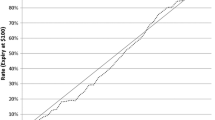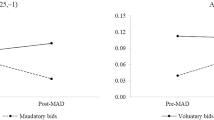Abstract
This paper illustrates the differences in the effects of seller-initiated versus buyer-initiated crowded trades in stock markets. First, a one-period multi-investor model is proposed to describe how crowded trades affect stock prices. Further, we theoretically decompose the crowded trades into buyer-initiated crowded trades and seller-initiated crowded trades and, respectively, analyse their effects on stock prices. An empirical study is conducted to examine the theoretical model, obtaining the following results. First, stock prices increase with crowded trades; second, stock prices are positively related to buyer-initiated crowded trades, but negatively related to seller-initiated crowded trades; and third, the effects of crowded trades, buyer-initiated crowded trades and seller-initiated crowded trades on stock prices are stronger for the younger stocks, lower price earnings ratio stocks, lower earnings per share stocks, and lower fixed asset ratio stocks. Collectively, our results can provide new insights into the roles of crowded trades on stock prices.
Similar content being viewed by others
Notes
The limit-up of the price limit is 10%, and the limit-down of the price limit is − 10% in Chinese stock markets.
RESSET Financial Research Database (RESSET) is mainly for colleges and universities, financial research institutions and research departments of financial enterprises in China, providing support for empirical research and model test. RESSET is designed by numerous experts from Tsinghua University, Peking University, and the London School of Economics.
Wind is the provider of financial data, information and services in mainland China. Wind has built a top-tier financial database focusing on securities data, with a wide coverage of equities, funds, bonds, foreign exchanges, insurance, futures, derivatives, commodities, macro-economy and financial news. The timely updated information is always there to satisfy institutional investors' diversified needs. Knowing the demand diversification among investment institutions, research institutes, academic institutes and government bodies, Wind has developed series of professional analytics and applications for indexing, data extraction and analysis, portfolio management and many other areas. With all these tools, users could get real-time, accurate and complete financial data and information and the analytical results.
In comparison, Chordia and Subrahmanyam (2004) use a sample for an average of 1322 NYSE stocks over 132 months from January 1988 to December 1998, about 4 billion transaction data. Kumar and Lee (2006) use a sample with 1,854,776 trades of individual stocks from one discount broker over 6 years (1991–1996). Bailey et al. (2009) use the transaction data of 198 stocks, including the current components of the Shanghai 180 index plus 18 stocks that were replaced after December 2003 for the period from October 2003 to March 2004.
Here, firm age (A) is the list age of stock; price earnings ratio (PE) is the ratio of stock price to per-share earnings; earnings per share (EPS) is the portion of a company's profit allocated to each outstanding share of common stock; and fixed assets (PPE) is the ratio of fixed assets to total assets.
\( C_{i,t}^{\mathrm{Rmrf}} \) is the day-t residual for individual stock \( i \) in the following equation: \( C_{i,t} = c_{0} + c_{1} {\mathrm{Rmrf}}_{t} + \varepsilon_{i,t} \). Using the same way, we can calculate \( C_{i,t}^{{{\mathrm{b}},{\mathrm{Rmrf}}}} \), \( C_{i,t}^{{{\mathrm{s}},{\mathrm{Rmrf}}}} \), \( C_{p,t}^{\mathrm{Rmrf}} \), \( C_{p,t}^{{{\mathrm{b}},{\mathrm{Rmrf}}}} \), and \( C_{p,t}^{{{\mathrm{s}},{\mathrm{Rmrf}}}} \).
The Shanghai Stock Exchange and Shenzhen Stock Exchange paused initial public offerings (IPO) from November 2012 to January 2014; therefore, we may remove the impacts of trading rules and IPO underpricing on stock returns by selecting the subsample from January 4, 2013, to June 26, 2013.
References
Aitken M, Cumming D, Zhan F (2015) Exchange trading rules, surveillance and suspected insider trading. J Corp Finance 34:311–330
Amihud Y (2002) Illiquidity and stock returns: cross-section and time-series effects. J Financ Mark 5(1):31–56
Avramov D, Chordia T (2006) Asset pricing models and financial market anomalies. Rev Financ Stud 19(3):1001–1040
Bailey W, Cai J, Yan LC, Wang F (2009) Stock returns, order imbalances, and commonality: evidence on individual, institutional, and proprietary investors in China. J Bank Finance 33(1):9–19
Baker M, Wurgler J (2006) Investor sentiment and the cross-section of stock returns. J Finance 61(4):1645–1680
Baltzer M, Jank S, Smajlbegovic E (2019) Who trades on momentum? J Financ Mark 42:56–74
Barberis N, Thaler R (2003) A survey of behavioral finance. In: Constantinides GM, Harris M, Stulz RM (eds) Handbook of the economics of finance, vol 1. Elsevier, Amsterdam, pp 1053–1128
Blocher J (2016) Network externalities in mutual funds. J Financ Mark 30:1–26
Bollerslev T, Li SZ, Todorov V (2016) Roughing up beta: continuous versus discontinuous betas and the cross section of expected stock returns. J Financ Econ 120(3):464–490
Bookstaber R, Foley MD, Tivnan BF (2016) Toward an understanding of market resilience: market liquidity and heterogeneity in the investor decision cycle. J Econ Interact Coord 11(2):205–227
Brogaard J, Li D, Xia Y (2017) Stock liquidity and default risk. J Financ Econ 124(3):486–502
Cen L, Lu H, Yang L (2013) Investor sentiment, disagreement, and the breadth-return relationship. Manag Sci 59(5):1076–1091
Chan K, Hameed A, Kang W (2013) Stock price synchronicity and liquidity. J Financ Mark 16(3):414–438
Chen J, Hong H, Stein JC (2002) Breadth of ownership and stock returns. J Financ Econ 66(2):171–205
Cheung YL, Ouyang Z, Weiqiang TAN (2009) How regulatory changes affect IPO underpricing in China. China Econ Rev 20(4):692–702
Chordia T, Subrahmanyam A (2004) Order imbalance and individual stock returns: theory and evidence. J Financ Econ 72(3):485–518
Chordia T, Roll R, Subrahmanyam A (2001) Market liquidity and trading activity. J Finance 56(2):501–530
Chordia T, Roll R, Subrahmanyam A (2002) Order imbalance, liquidity, and market returns. J Financ Econ 65(1):111–130
Chordia T, Subrahmanyam A, Tong Q (2014) Have capital market anomalies attenuated in the recent era of high liquidity and trading activity? J Account Econ 58(1):41–58
Chordia T, Hu J, Subrahmanyam A, Tong Q (2017) Order flow volatility and equity costs of capital. Manag Sci 65:1520–1551
Cremers M, Halling M, Weinbaum D (2015) Aggregate jump and volatility risk in the cross-section of stock returns. J Finance 70(2):577–614
Cumming D, Johan S, Li D (2011) Exchange trading rules and stock market liquidity. J Financ Econ 99(3):651–671
Datar VT, Naik NY, Radcliffe R (1998) Liquidity and stock returns: an alternative test. J Financ Mark 1(2):203–219
Ding R, Hou W (2015) Retail investor attention and stock liquidity. J Int Financ Mark Inst Money 37:12–26
Eckbo BE, Norli Ø (2005) Liquidity risk, leverage and long-run IPO returns. J Corp Finance 11(1–2):1–35
Eiling E (2013) Industry-specific human capital, idiosyncratic risk, and the cross-section of expected stock returns. J Finance 68(1):43–84
Fama EF, French KR (1992) The cross-section of expected stock returns. J Finance 47(2):427–465
Fama EF, French KR (1993) Common risk factors in the returns on stocks and bonds. J Financ Econ 33(1):3–56
Fu F (2009) Idiosyncratic risk and the cross-section of expected stock returns. J Financ Econ 91(1):24–37
Gerhold S, Guasoni P, Muhle-Karbe J, Schachermayer W (2014) Transaction costs, trading volume, and the liquidity premium. Finance Stoch 18(1):1–37
Han B, Kumar A (2013) Speculative retail trading and asset prices. J Financ Quant Anal 48(2):377–404
Hanson SG, Sunderam A (2014) The growth and limits of arbitrage: evidence from short interest. Rev Financ Stud 27(4):1238–1286
Hausman JA (1978) Specification tests in econometrics. Econom J Econom Soc 46:1251–1271
Hendershott T, Jones CM, Menkveld AJ (2011) Does algorithmic trading improve liquidity? J Finance 66(1):1–33
Hong H, Li W, Ni SX, Scheinkman JA, Yan P (2015) Days to cover and stock returns. NBER working paper
Hou K, Moskowitz TJ (2005) Market frictions, price delay, and the cross-section of expected returns. Rev Financ Stud 18(3):981–1020
Jia Y, Yang C (2017) Disagreement and the risk-return relation. Econ Model 64:97–104
Kimbro MB (2005) Managing underpricing? The case of pre-IPO discretionary accruals in China. J Int Financ Manag Account 16(3):229–262
Kumar A, Lee C (2006) Retail investor sentiment and return comovements. J Finance 61(5):2451–2486
Lee C, Ready MJ (1991) Inferring trade direction from intraday data. J Finance 46(2):733–746
Li L (2006) Can corporate governance variables explain short-term IPO returns?: A study of the Chinese market. Account Account Perform 12(1):64
Li M, Zheng H (2017) Heterogeneous trading and complex price dynamics. J Econ Interact Coord 12(2):437–442
Ma R, Anderson HD, Marshall BR (2018) Stock market liquidity and trading activity: Is China different? Int Rev Financ Anal 56:32–51
Menkveld AJ (2014) Crowded trades: an overlooked systemic risk for central clearing counterparties. SSRN working paper
Pagano M (1989) Trading volume and asset liquidity. Q J Econ 104(2):255–274
Pojarliev M, Richard ML (2011) Detecting crowded trades in currency funds. Financ Anal J 01:26–39
Shang H, Yuan P, Huang L (2016) Macroeconomic factors and the cross-section of commodity futures returns. Int Rev Econ Finance 45:316–332
Sias R, Turtle HJ, Zykaj B (2015) Hedge fund crowds and mispricing. Manag Sci 62:764–784
Stein JC (2009) Presidential address: sophisticated investors and market efficiency. J Finance 64(4):1517–1548
Yan P (2013) Crowded trades, short covering and momentum crashes. SSRN Working Papers. 2404272, Social Science Research Network, Inc. http://ssrn.com/abstract=2404272
Yang C, Zhou L (2016) Individual stock crowded trades, individual stock investor sentiment and excess returns. N Am J Econ Finance 38:39–53
Zhou L, Yang C (2019) Stochastic investor sentiment, crowdedness and deviation of asset prices from fundamentals. Econ Model 79:130–140
Acknowledgements
We are especially grateful to the editor (Prof. Thomas Lux), the Associate Editor and anonymous referees for constructive comments that have significantly improved the paper. This work was supported by the National Natural Science Foundation of China (71803051), the Natural Science Foundation of Guangdong Province (2018A030310218); the project of Guangdong Planning office of Philosophy and Social Science in 2017 (GD17XLJ04; GD17XGL14), the youth project of Department of Education of Guangdong Province (2017WQNCX014), National Science Foundation of China (71471067; 71720107002), and China Postdoctoral Science Foundation (2019M652913).
Author information
Authors and Affiliations
Corresponding author
Additional information
Publisher's Note
Springer Nature remains neutral with regard to jurisdictional claims in published maps and institutional affiliations.
Rights and permissions
About this article
Cite this article
Zhou, L., Yang, C. Differences in the effects of seller-initiated versus buyer-initiated crowded trades in stock markets. J Econ Interact Coord 14, 859–890 (2019). https://doi.org/10.1007/s11403-019-00264-3
Received:
Accepted:
Published:
Issue Date:
DOI: https://doi.org/10.1007/s11403-019-00264-3




